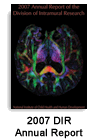Unit on Chromosome Structure and Function
Head: Alexander V. Strunnikov
Our group focuses on understanding both the biological role and mechanism of higher-order chromosome structure as related to chromosome segregation. The eukaryotic ATP-ases of the SMC (structural maintenance of chromosomes) family form several essential protein complexes that determine higher-order chromosome structure and chromatin dynamics in eukaryotic cells. We mainly study mitotic chromosome condensation. The SMC complex condensin constitutes the main molecular machine of chromosome condensation. Condensin is conserved in eukaryotic evolution and, in budding yeast, is composed of five essential subunits: Smc2, Smc4, Ycs5/Ycg1, Ycs4, and Brn1. It is likely that condensin’s vital activity is to bind to DNA and change its superhelical state, thereby introducing positive DNA supercoiling. Currently, our work on molecular mechanisms of condensin activity addresses three major objectives: (1) to characterize regulatory pathways that target condensin to specific chromosomal sites in mitosis; (2) to examine condensin’s requirements for distinctive chromosomal domains, such as nucleolar organizer and centromeres; and (3) to define quantitative changes introduced into DNA in vivo during chromosome condensation. We identified several regulatory circuits and cellular requirements for condensin function (Figure 3.3) and continue to study the essential hubs of condensin activity in chromatin.
Resources
- Employee Listing
- E-Mail the Lab: strunnik@box-s.nih.gov
- UCSF Home Page




